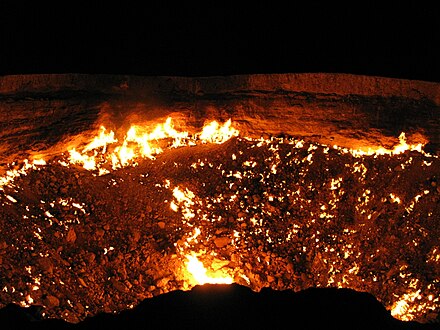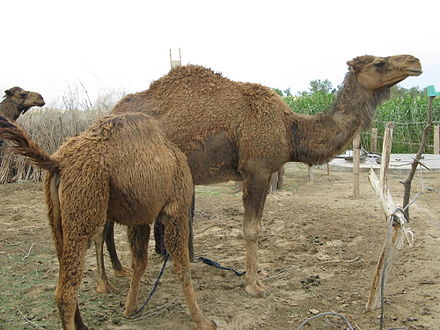Karakum - desert

Villages
There are no cities in this vast and mostly empty quarter of the country, but there are a few small villages.
- Some inhabitants of the village of Erbent 📍 (Ýerbent), and possibly some other villages, will prepare traditional meals for passing tourists. Talk to the tour company or driver.
- There are a number of other smaller villages along the main highway through the desert, but don't expect these villages to have anything more than a basic store. If you've forgotten anything, find one of these villages well before you get to the gas crater.
- The closest settlement to the crater (the former settlement of Derweze has long been abandoned) is a tiny village named Aeroport. It does not have an airport, or likely much in the way of services at all (it is extremely small) so don't count on getting anything there except possibly aid in an emergency.
Other destinations
- The Mud Crater 📍 and the turquoise Water Crater 📍, two more craters result of industrial accidents, just off the highway towards Ashgabat. Neither of these is as spectacular as star attraction Derweze, but they are an interesting diversion on the more than five hour drive from the capital. Unlike the Gas Crater, these two come with safety fencing. The Water Crater has a fun echo effect.
Understand
As the most remote part of one of the world's most remote countries, there's basically one attraction here, and that's the burning hole in the ground.
- Door to Hell (Jähennem derwezesi, Җәхеннем дервезеси), 40.25263°, 58.43939°. The Door to Hell itself, however, does not disappoint, and the sheer sight of this industrial disaster turned accidental pyrotechnic wonder is well worth the five-hour journey from Ashgabat.
The whole area is rich in natural gas and while drilling in 1971, Soviet geologists tapped into a cavern filled with natural gas. The ground beneath the drilling rig collapsed, leaving a large hole with a diameter of more than 70 m (230 ft) and they decided the best solution was to flare the gas. They hoped the fire would use all the fuel in a matter of days, but the gas is still burning today, more than 50 years later!
You might want to arrive during the daytime, when the crater is impressive but not stunning, and then wait as night falls, when the Door to Hell erupts into a spectacular show. Camping just beyond the pit on the nearby dunes is highly recommended.
There's two other craters to see, and stopping in some of the desert villages can be fun, but these aren't worth the trek on their own, and virtually every tourist who ventures here comes for the Derweze crater.
Talk
Virtually everyone in the Karakum will speak nothing but Russian and Turkmen, making having a guide through the region all the more essential, particularly if you run into a health or safety issue.
Get in
Getting into the Karakum desert isn't particularly difficult–just follow the only highway north out of Ashgabat or South out of Konye Urgench. However, most people wishing to visit the Karakum intend to visit the gas crater, which involves somewhat more preparation.
To visit the crater requires driving off-road on the loose sand for significant but not excessive distance. However, as such, the drive should not be undertaken by those without off-road experience, and doing so in a rental car (if you can get one) will almost certainly violate your contract. Moreover, the Ladas (well, nowadays they are mostly Toyota Camrys) that rule the roads of Turkmenistan are ill-fit for the drive, it is better to stick with a 4WD. Thus for most visitors, it will make sense to stick with an official tour.
For those who are in Turkmenistan on a prearranged tour, including those offered by well-known outfits Koryo Tours and Stan Tours, Derweze is naturally on the itinerary for most of them.
Aside from the big names, Silk Road Adventures offers tours with 12-hour notice from Ashgabat, but they do not offer an overnight option. Local company Ayan Travel offers a three day Derweze trip as well as a handful of desert tours that do not go to Derweze... perfect for those who don't just want to go off the beaten path, but want to leave paths behind altogether.
Expect tours to be on the expensive side, but it is well worth it given the safety risks involved in organizing your own trip.
For those who are more a bit more adventurous or daring, it is possible to arrange a Derweze trip oneself, but it takes considerable work to make sure you end up with a safe trip. It probably helps to have Turkmen contacts who can point you to someone with the correct type of vehicle.
Likewise, it is possible to visit the crater by a combination of public transport and foot (if you're on a transit visa and travelling unaccompanied.):
- Take a share taxi to the chaikhana just north of the Derweze truck stop. You’ll likely have to pay the fare for the whole Ashgabat/Konye Urgench trip, as the driver won’t be able to find passengers to replace you when you get out in Derweze. Alternatively, take a bus from the Ashgabat International Bus Station to Derweze. The 08:00 bus arrives in Derweze at 10:55 and costs 13.5 manat. Purchase ticket a day in advance.
- Ask at the chaikhana for a local driver to take you off road out to the crater. Or walk to the crater. In summertime this should ideally be done in the late afternoon once the temperature has cooled a bit. This, of course, means that you'll need a tent to camp out near the crater overnight. The staff at the chaikhana may be willing to store excess baggage in their back room while you're out walking to the crater.
- A compass is helpful when walking to the crater. Head (magnetic) east-northeast from the chaikhana for 1.5 to 2 hours. If you leave in the late afternoon, the glow of the crater will guide you, even if you aren’t perfect with your navigation. Resist the temptation to follow the jeep/motorcycle tracks. They go the long way around the dunes, and it’s much quicker and easier for you to just climb over them.
- Return the same way to the chaikhana. Finding onward transportation may be somewhat difficult as share taxis are usually full when they make the trip. Hitchhiking is a viable option, as most trucks and other vehicles stop at either the truck stop down the road or the chaikhana.
Get around
All getting around is done either in the vehicle you came in or on foot. There's no public transport here!
See and do
Aside from the craters and Erbent, which given the difficulty of reaching them are more destinations than sights, there isn't much to actually see in the Karakum. Mostly just sit in the desert and marvel at the emptiness and incredible scenery.
Sleep
There is no accommodation to be had in the desert except that which you bring yourself (or your tour group brings)–a tent. There are no facilities of any kind at the gas crater, not even toilets.
Eat

Drink
Somewhat surprisingly, the full range of (Turkmen) alcoholic drinks is available at the village stores, so you can stock up and have a "beach party" at the lake of fire if you would so like.
In the villages you're most likely to get tea to drink, but you may also be offered the chance to try fermented camel's milk, a traditional drink in the area and better-tasting than it sounds. You may also be offered raw camel's milk, but be aware that people do get sick from it (the villagers should warn you as such when offering).
Given that this is a desert, make sure to bring lots of water and drink it frequently.
Stay safe
Practice desert safety. Most of the transportation will likely be left to someone other than the traveller, but do remember to bring water and drink it frequently, and shade your head and eyes from the fierce sun.
It cannot be stressed enough, make sure you have a vehicle that can handle the terrain. If you're going anywhere off the highway, hire a 4WD.
The gas crater does not have safety features of any kind. Always stay at least 1 metre away from the edge, as the ground has been known to crumble. The pit has grown since it first appeared in 1971.
Go next
It's halfway around the world, but if your curiosity has been piqued about indefinitely burning underground fires, Centralia, Pennsylvania, USA is the only other place you can see something similar, although that fire is buried in a coal mine, not roaring in an open pit.
Otherwise, most visitors have two choices, continue on the road or go back where they came from. Since there's only one real road, for all practical purposes this means your next stop will be either Ashgabat or Konye Urgench.
Karakum Desert
Date Time:Please wait...Timezone:Asia/AshgabatCoordinates:39.00, 60.00

